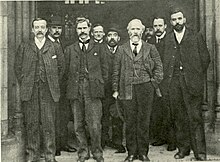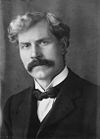Arthur Henderson
Robert Crewe-Milnes
| |||||||
|---|---|---|---|---|---|---|---|
| |||||||
| Personal details | |||||||
| Born | 13 September 1863 Glasgow, Scotland | ||||||
| Died | 20 October 1935 (aged 72) London, England | ||||||
| Political party | Labour | ||||||
Arthur Henderson (13 September 1863 – 20 October 1935) was a British
Early life
Arthur Henderson was born at 10 Paterson Street,
Henderson worked at Robert Stephenson and Sons' General Foundry Works from the age of twelve. After finishing his apprenticeship there aged seventeen, he moved to
Henderson became a
Union leader
In 1892, Henderson entered the complex world of trade union politics when he was elected as a paid organiser for the
The Labour Party

In 1900 Henderson was one of the 129 trade union and socialist delegates who passed
In 1906, the LRC changed its name to the Labour Party and won 29 seats at the general election. In 1908, when Hardie resigned as Leader of the Labour Party, Henderson was elected to replace him. He remained Leader until his own resignation two years later, in 1910.
Cabinet Minister
In 1914 the
In 1915, following Prime Minister
In 1916,
Henderson turned his attention to building a strong constituency-based support network for the Labour Party. Previously, it had little national organisation, based largely on branches of unions and socialist societies. Working with Ramsay MacDonald and Sidney Webb, Henderson in 1918 established a national network of constituency organisations. They operated separately from trade unions and the National Executive Committee and were open to everyone sympathetic to the party's policies. Secondly, Henderson secured the adoption of a comprehensive statement of party policies, as drafted by
The "Coupon Election" and the 1920s
Henderson lost his seat in the "Coupon Election" of 14 December 1918, which had been announced within twenty-four hours of the end of hostilities and which resulted in a landslide victory for a coalition formed by Lloyd George.[8] Henderson returned to Parliament in 1919 after winning a by-election in Widnes. He then became Labour's Chief Whip.
Henderson
In 1924, Henderson was appointed as Home Secretary in the first-ever Labour government, led by MacDonald. This government was defeated later the same year and lost the general election that followed.
Having been re-elected in 1924, Henderson refused to challenge MacDonald for the party leadership. Worried about factionalism in the Labour Party, he published a pamphlet, Labour and the Nation, in which he attempted to clarify the party's goals.
Foreign Secretary
In 1929, Labour formed
The MacDonald "betrayal"
The
Later career
Henderson returned to Parliament after winning a by-election at Clay Cross, achieving the unique feat of being elected five times at by-elections in constituencies where he had not previously been the MP. He holds the record for the greatest number of comebacks from losing a previous seat.
Henderson spent the rest of his life trying to halt the gathering storm of

Henderson died in 1935, aged 72, and was cremated at
The Labour History Archive and Study Centre at the People's History Museum in Manchester holds the papers of Arthur Henderson in their collection, spanning from 1915 to 1935.[15]
Works
See also
Citations
- ^ "Arthur Henderson".
- ^ "Arthur Henderson: a Labour pioneer". The Northern Echo.
- ^ Christopher Howard, "MacDonald, Henderson, and the Outbreak of War, 1914." Historical Journal 20.4 (1977): 871-891. online
- ISBN 0713103167.
- ^ UK National Archives, CAB 23-3, pg. 372 of 545
- ISBN 978-0-333-56081-5, retrieved 16 June 2022
- ^ Bentley B. Gilbert, Britain since 1918 (1980) p 49.
- ^ Katz, Liane (4 April 2005) "Women and the Welsh Wizard". Politics.guardian.co.uk. Retrieved on 12 September 2015.
- ISBN 0300076622.
- ^ "Письмо Г.В. Чичерину. 10 февраля 1922 г." [Letter to G. V. Chicherin, 10 February 2022]. docs.historyrussia.org. 15 July 2023. Archived from the original on 15 July 2023.
- ISBN 9781349006755.
- ^ Andrew Thorpe, "Arthur Henderson and the British political crisis of 1931." Historical Journal 31#1 (1988): 117-139. in JSTOR
- ^ "Nobel Peace Prize medal stolen in Newcastle". BBC News. 3 April 2013. Retrieved 13 March 2023.
- ^ "Newcastle man jailed for Nobel Peace Prize medal theft". BBC News. 2 October 2013. Retrieved 13 March 2023.
- ^ Collection Catalogues and Descriptions, Labour History Archive and Study Centre, archived from the original on 13 January 2015, retrieved 20 January 2015
Sources
- Buckle, George Earle (1922). . In Chisholm, Hugh (ed.). Encyclopædia Britannica (12th ed.). London & New York: The Encyclopædia Britannica Company.
- Carlton, David (1970). MacDonald versus Henderson: The Foreign Policy of the Second Labour Government. Palgrave Macmillan. ISBN 9781349006755.
- Hamilton, Mary Agnes. Arthur Henderson: A Biography (1938), a detailed and favourable account by a former colleague
- Howard, Christopher. "MacDonald, Henderson, and the Outbreak of War, 1914." Historical Journal 20.4 (1977): 871–891. online
- McKibbin, Ross. "Arthur Henderson as Labour Leader," International Review of Social History (1978) pp. 79–101
- Riddell, Neil. "Arthur Henderson, 1931–1932," in Leading Labour: From Keir Hardie to Tony Blair, ed. Kevin Jefferys (1999)
- Thorpe, Andrew. "Arthur Henderson and the British Political Crisis of 1931," Historical Journal (1988) pp. 117–139 in JSTOR
- UK National Archives, online
- Winkler, Henry H. "Arthur Henderson," in The Diplomats, 1919–1939, ed. Gordon A. Craig and Felix Gilbert (1953)
- Winter, J M. "Arthur Henderson, the Russian Revolution and the Reconstruction of the Labour Party," Historical Journal (1972) pp. 753–73. in JSTOR
- Wrigley, Chris. Arthur Henderson (1990), a scholarly biography
External links
- Hansard 1803–2005: contributions in Parliament by Arthur Henderson
- Arthur Henderson on Nobelprize.org including the Nobel Lecture, 11 December 1934 Essential Elements of a Universal and Enduring Peace
- J. Keir Hardie and Arthur Henderson, Manifesto to the British People Archived 31 August 2018 at the Wayback Machine (1 August 1914)
- Parliamentary Archives, Papers of Arthur Henderson MP on the Disarmament Conference in Geneva, 1932
- Newspaper clippings about Arthur Henderson in the 20th Century Press Archives of the ZBW



